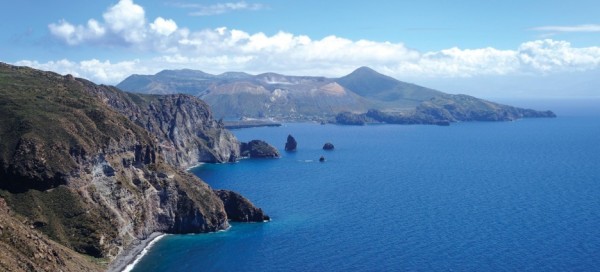The Aeolian islands may be only around 20 miles off the north coast of Sicily but they offer visitors a holiday experience quite different from that on their big southern neighbour. While both share thousands of years of history, fresh seafood cuisine and regular pyrotechnic displays from their resident volcanoes, the Aeolian islands offer something a little less polished and rough around the edges, but with more than enough of interest to make them worthy of exploration.
In Greek mythology Aeolus was the ruler of winds, and gave a pig skin bag packed full of favourable winds to Odysseus so that he could sail home to Ithaca. Whatever your beliefs in Greek mythology, the geological origins of the islands are not in dispute. They were formed as the result of thousands of years of volcanic activity, with those volcanic characteristics very much on display today, especially on Stromboli and Vulcano.
It is to Lipari that most visitors make their first stop on the Aeolian Islands. The largest of the 7 inhabited islands, it’s also the only one with a decent-sized town and most of the ferries stop here even if they’re on their way to the other islands. Lipari is a tourist hotspot in the summer months and the rows of gift shops and tourist restaurants may not be to everyone’s taste, but it certainly has a few attractions worth exploring. And while it’s worth asking around for recommendations for a good place to eat away from the crowds, providing you like seafood the abundance of fresh produce means that you’re unlikely to go too far wrong wherever you eat.
The acropolis or castle complex is the most striking landmark of Lipari, its imposing walls and towers visible from the sea. While most of what you see when you take a wander around the walls is from the 15th century, the island (and the area around the fortress) has been inhabited for at least 7000 years. The volcanic nature of the island can be seen at first hand at the thermal springs of San Calogero, where the rocks have been coloured in blue, red, green and orange by the sulphur steaming from the fumaroles.
Stromboli
If you’re coming to the Aeolian Islands to see volcanic action at first hand then a visit to Stromboli is a must. The island is essentially a single volcano which has been spitting out a colourful flow of lava for two thousand years. Daily two-hour walks head out onto the volcano to watch the sunset and see the dramatic display in the evening light.
Vulcano
For a slightly different volcanic experience head to Vulcano, the closest of the islands to Sicily. Here you can wallow in mud pools, swim in the sea above warm off-shore fumaroles and hike up the volcano crater. Be aware though that the rotten-egg smell of the volcano is impossible to escape and you might choose to visit Vulcano as a day-trip, retreating to the relatively clean air of Lipari when it’s time to eat and sleep.





